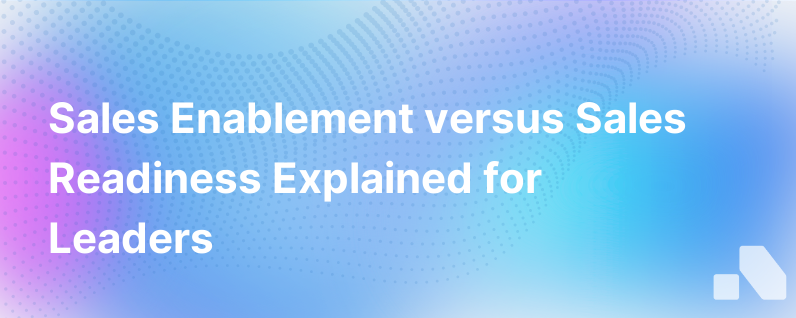
Sales are the lifeblood of any organization. Within the realm of sales performance, two terms are often bandied about: sales enablement and sales readiness. While they may sound similar, their distinctions are pivotal for understanding how to optimize your sales force's performance.
In this detailed exploration, we will delve into the nuances between sales enablement and sales readiness, offering insight into creating a robust sales strategy capitalized on both constructs.
Understanding Sales Enablement
Sales enablement is a strategic, ongoing process that provides sales teams with the resources needed to close more deals. These resources may include content, tools, knowledge, and information to sell products or services effectively.
This process aligns marketing with sales. Marketing creates the assets and tools sales need, like case studies, product data sheets, or customer testimonial videos, while sales use these resources to engage prospects and close deals. Sales enablement can also include CRM systems that manage customer data, and sales enablement platforms that organize sales content and track its usage.
An effective sales enablement strategy ensures that every sales rep can access the right content at the right time to advance their sales conversations. Let's break sales enablement down further:
- Content Management: Collating and managing all the content produced for sales. It includes ensuring the content is up-to-date, easily accessible, and efficiently utilized.
- Training Tools: Providing sales reps with training materials, which range from product training to soft skills development.
- Sales Process: Establishing a clear sales process supported by content and tools that align with the customer's journey.
- Technology: Implementing and managing the sales tech stack that enables the tracking and delivery of content, and provides insights into content usage and buyer engagement.
The effectiveness of sales enablement can be measured by tracking content usage, sales cycle length, win rates, and other sales metrics. It's crucial to continually measure and optimize sales enablement strategies to ensure they support the bottom line effectively.
Delineating Sales Readiness
Sales readiness, while similar to sales enablement, focuses specifically on ensuring each individual sales representative is prepared to engage buyers throughout the customer lifecycle.
This involves equipping salespeople with not just the knowledge and tools they need but ensuring they can apply their skills effectively. It's about evaluating and improving how prepared and confident reps are in potential sales scenarios.
Key facets of sales readiness could include:
- Training and Coaching: Ongoing assessment-driven sales training and coaching to reinforce skills and ensure mastery.
- Measuring Competence and Confidence: Regularly gauging the reps’ ability to sell effectively, and how well they know the product and process.
- Competitor Knowledge: Ensuring reps are well-versed in the competitive landscape and can confidently position your offerings against competitors.
- Sales Simulations and Role-Playing: Conducting role-play sessions to practice scenarios encountered in the sales process. This training ensures reps are ready to put their training into action.
- Certification Programs: Formal programs to certify reps in particular products, industries, or selling techniques.
Sales readiness is a critical part of a sales rep's success. By ensuring reps are always ready to engage with a prospect or upsell to a current customer, businesses can increase their chance of success in each interaction. This efficacy is often measured through observing deal outcomes, examining win-loss ratios, and soliciting feedback from personnel within sales training roles.
The Intersection and Interaction
Sales enablement and sales readiness might have distinct focal points, but they are interdependent. Without a strong enablement strategy, sales readiness efforts lack the solid foundation necessary for triggering notable success. Conversely, without sales readiness, the tools and resources forged through enablement strategies remain underutilized.
This symbiotic relationship should be nurtured to ensure a virtuous cycle of information and skills development is achieved.
A Real-World Application Scenario
Consider a scenario where a company launches a new software product. The marketing team prepares brochures, FAQ documents, and a features overview as part of sales enablement. However, the sales rep needs to be confident and articulate in communicating how the software solves a client's specific problem – this is where sales readiness comes in – through training sessions, role-playing exercises, certification, and other forms of preparation to ensure this confidence and articulation.
Closing Thoughts
In practice, while sales enablement provides the "what" – such as what to say or give to a prospective client – sales readiness is about the "how" – ensuring the sales rep delivers the message compellingly and convincingly.
Each area requires a different strategy, management, and support, but both need to be considered in an organization's overall sales strategy. Through a harmonious balance of the two, organizations can truly empower their sales teams, leading not only to improved sales metrics but also to a stronger and more competitive position in the marketplace.